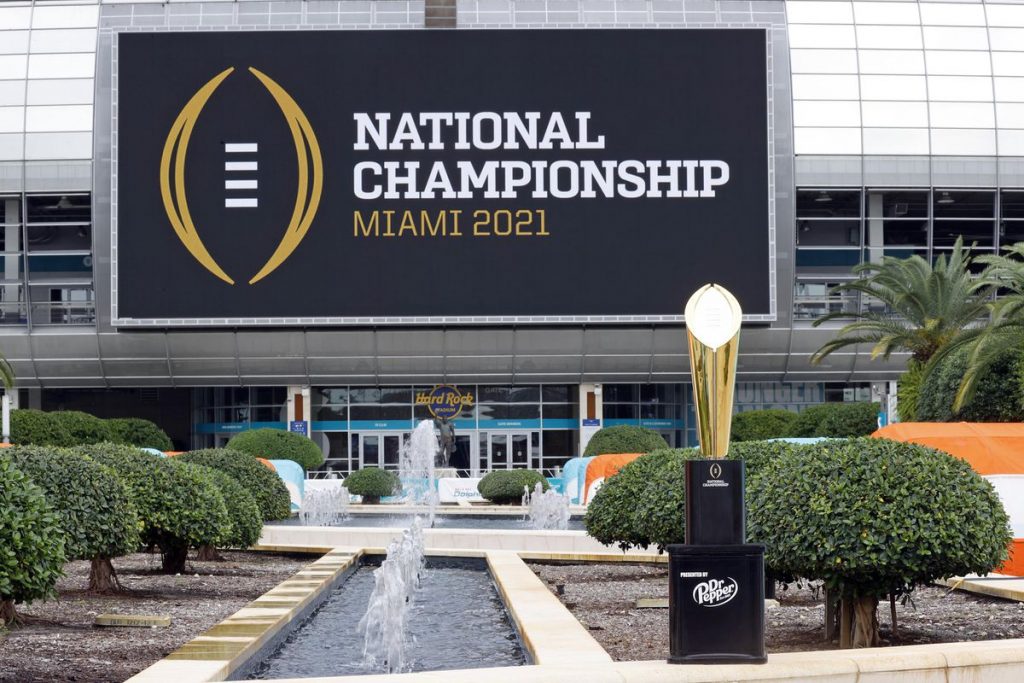How to Fix the College Football Playoff

Getty Images/Joel Auerbach
The College Football Playoff has been around since 2015. In those seven years, we’ve had four different National Champions, including two teams with multiple titles. Ohio State won the first edition of the Playoffs, upsetting Alabama in the 2015 Sugar Bowl, and thrashing Marcus Mariota and the Oregon Ducks in the National Championship game, winning 42-20. All of a sudden, this was the new system we could get behind for a considerable amount of time. In 2016, we saw the beginning of the Alabama/Clemson saga. Over the next four years, the Tide and the Tigers met four times, in three title games, and one semi-final game. The two dynasties split these games 2-2, with each team winning titles out of the victory.
In 2020, we realized, more than ever, that there was a clear bias towards the big-name teams and conferences by the Playoff committee. Teams like Cincinnati, Louisiana, Coastal Carolina, BYU, and Liberty played phenomenal regular-seasons but got no love by the playoff committee. Cincinnati entered conference championship week as the ninth-ranked team, despite having fewer losses than five of the teams ranked above them. The Bearcats had zero losses, but they fell each week because the coronavirus kept them from being able to play a few games in December. Never mind the fact that Ohio State didn’t even meet the minimum game requirement to qualify for the Big Ten Championship game. It’s clear, in my opinion, that the current, four-team system just doesn’t cut it.
One of the main arguments against playoff expansion has been “we don’t want blowouts.” Well, do I have news for members of that crowd. Did you see the final scores of all three playoff games in 2021? 31-17. 49-28. 52-24. The average margin of victory in these playoffs was 23.3 points. The average margin of victory in the seven-year history of these playoffs is 19.3 points. Only 6 of the 21 games (2 of every 7) have been decided by 7 or fewer points. The College Football Playoff is more than used to blowouts at this point. Granted, we’ve had these results because the champions have just been so much better than everyone else. But, if we’re going to see three boring “playoff” games a year, why not have a little fun with it? Could you imagine if this year’s Orange Bowl was a Playoff game? What about the comeback by the Georgia Bulldogs in the Peach Bowl?
MY PROPOSITION:
This is definitely far-fetched, as the CFP Committee has shown no want to expand, but here is what I would propose, if given the chance.
NUMBER OF TEAMS AND QUALIFICATIONS:
I would propose an expansion to eight teams, with each Power 5 champion receiving an Automatic Bid, just like in LITERALLY EVERY other NCAA sport. The best Group of 5 team would also receive an Auto-bid. The remaining two teams would be At-Large bids, just like in March Madness or the Baseball and Softball tournaments. We would set a minimum game requirement at 10, and just for the heck of it, require all teams to be affiliated with a conference, sorry, not sorry, Notre Dame.
On that note, ban Notre Dame from the playoffs. Kidding, maybe.
TIME, DATE, AND LOCATION
Do we really need 21 days between Selection Sunday and the Semi-Finals? No. In Baseball, teams find out on Monday that they have to fly across the country and begin regional play on Thursday. On the hardwood, teams are told on Sunday night that they have to go to Dayton to play on Tuesday to see if they even make the field of 64.
We select teams on Sunday and put them on the field on the following weekend. The higher seed would get to host the first round at their home stadium, giving fans another chance to watch them without flying across the country. We could take a page from the NFL playbook and put a game on Friday night, and play three games on Saturday. I’d also give FOX, CBS, ABC, and ESPN one game each, covering their normal conference (example later on)
We take a break for Christmas and play the semis in a traditional New Year’s Six bowl on or around January 1. This is where it gets hairy. The four NY6 bowls that aren’t playoff games could either be filled by the losers of the Quarterfinal, or by eight new teams, say teams 9-16 in the rankings. This would allow us to lower bowl eligibility to 5-7, and also remove conference affiliations with bowl games. I would personally pick the latter, since those losing teams won’t care enough to play a good bowl game.
HOW WOULD THIS LOOK IN 2020?
This would’ve been how it would’ve looked, had this been implemented in 2020, with Selection Sunday on December 6, as it usually is:
- 1. Alabama Crimson Tide (SEC AQ) vs 8. Oregon (PAC-12 AQ) @ Bryant-Denny Stadium; Saturday, Dec. 12, 3:30 EST – CBS
- 2. Clemson Tigers (ACC AQ) vs 7. Cincinnatti (Go5 AQ) @ Clemson-Memorial Stadium; Friday, Dec. 11, 7:30 EST – ESPN
- 3. Ohio State (Big Ten AQ) vs 6. Notre Dame (At-Large) @ Ohio Stadium; Saturday, Dec. 12, Noon EST – FOX
- 4. Texas A&M (At-Large) vs 5. Oklahoma (Big 12 AQ) @ Kyle Field; Saturday, Dec. 12, 7:30 EST – ABC
SEMIS
- 1/8 winner vs 4/5 winner: Rose Bowl; Jan. 1, 3:30 EST – ABC
- 2/7 winner vs 3/6 winner: Sugar Bowl; Jan. 1, 7:30 EST – ABC
NATIONAL CHAMPIONSHIP
- SEMIFINAL #1 winner vs SEMIFINAL #2 winner; Miami, FL; Jan. 11, 7:30 EST – ABC
NEW YEAR’S SIX BOWLS
- Cotton Bowl: 9 Florida vs 10 Iowa State
- Peach Bowl: 11 Georgia vs 12 Indiana
- Orange Bowl: 13 Coastal Carolina vs 14 North Carolina
- Fiesta Bowl: 15 BYU vs 16 Northwestern
Obviously, this is just a fun way to look at it. I would love the idea of expanding and giving more teams an opportunity to compete to win a National Championship. It isn’t good for fans to have a fairly good idea of the Top-4 teams before the previous season even ends. In fact, I’m willing to say that, barring absolute collapse, Alabama, Clemson, or Ohio State will be in the playoffs. In fact, each of the seven seasons of the College Football Playoff have featured at least two of those teams. We need to see change with the way we crown champions, or else college football could be heading down a dark path, from a national perspective.






